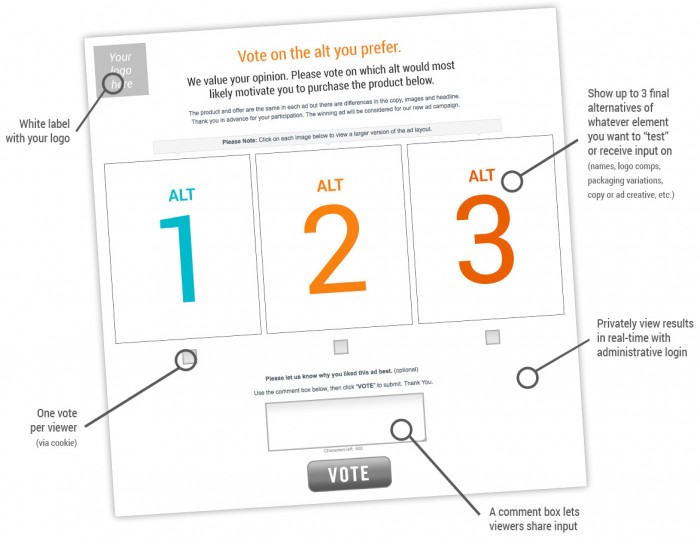Driving your business efforts down a data-backed track is your first-class ticket to success station.
OK, so that may sound a little corny. What’s not corny is basing your business marketing decisions on research to lock in rewarding outcomes. Better yet, many market research techniques are available using the web.
Glean insights into audience preferences and opinions by adopting these four trends in market research.
1. Real-Time Concept Testing
What if we said there was a way to get instant, affordable feedback from your target audience before launching a new concept for your business? Anything from opinions on a new advertising campaign, to names for a product or service, to new flavors, sizes, pricing…you name it!
With Real-Time Concept Testing, this assortment of feedback is at your fingertips.
Real-Time Concept Testing allows you to crowdsource votes and opinions regarding nearly anything related to your brand, products and services.
By giving your audience a voice in new marketing launches or directions, you will uncover valuable insights into your customers’ thoughts and validate your business choices. Real-Time Concept Testing is your crutch for avoiding pitfalls in your marketing decisions so you will be successful the first go-round. Discover what alternative your audience prefers and then bolt forward with the big winner!
Real-Time Concept Testing:
- Is 100% integrated on a digital stage. No phone calls. No manual surveys. No expensive focus groups.
- Provides real-time audience feedback. View results and participant comments in real-time with an administrative login.
- Is quick, easy and flexible. Show up to 3 alternatives of whatever element you want to “test” or receive input on easily and cost-effectively.

2. Virtual Focus Groups
Another trend gaining traction in market research is the virtual focus group. The nature of a standard focus group requires a hefty time and money investment, positioning focus groups in an unappealing light.
To conquer this setback, many businesses are opting for the virtual focus group to collect qualitative data.
The main benefit of a virtual focus group is facilitating a group conversation among target members without the hassle of gathering everyone together in one physical room. A moderator guides and controls the conversation in the chat room with the ability to share images or other media for participants to comment on. Transcripts of the focus group are available immediately since participants type the responses.
Another option is to use web cameras and other online conferencing technology to capture the group conversation verbally. Video files can then easily be played back for later reference.
An additional benefit of conducting online focus groups includes participant objectivity. Communicating through a screen signals participants to let their guard down and tell it like it is. By eliminating the face-to-face interaction, participants don’t feel obligated to impress the research team or spit out responses they think the researcher wants to hear. In turn, researchers collect honest, unbiased responses.
3. Online Surveys
Online surveys act as a fast pass for amassing answers to nearly any research quandary. Whether you’re hungry for feedback to drive business strategies or even anxious to spot developing trends in your industry, a customized online questionnaire will deliver real-time results.
Quick tips to keep in mind when developing an online survey:
- Start with simple questions. Avoid placing hard-hitting questions at the very beginning of your survey that may discourage participation in your research. Ease participants in with questions that trigger a quick, easy-to-make response.
- Keep the survey short. We recommend building online surveys with no more than 10-12 questions.
- Avoid eating the whole pie at once. Distribute your survey to only a portion of your database instead of the entire list. We recommend asking your audience to participate in no more than one online survey every six months.
- Ask for help. Contacting a professional survey organization will ensure your survey is launched without a hitch. Harp’s eSurvey, for example, is designed to custom fit your research needs. We’ll ensure you receive an adequate response rate, the questions are targeted, and we’ll even provide recommendations based on the survey feedback.
4.Geofencing (Mobile Surveys)
According to a survey exploring the adoption of new research methods by clients and suppliers, 64% of respondents reported already using mobile surveys while another 26% reported the method was under consideration.
Geofencing is one mobile survey technique you can implement to capture feedback from target audience members in a specific location.
How does it work? A virtual fence is drawn around a specific geographical location. When someone enters the fence with a smartphone that is location-enabled, a notification is triggered to alert that person to take the survey. This geofencing research method is valuable to businesses seeking feedback from in-store or on-site customers.
Seeking market research assistance?
We will work with you to figure out which market research approach is best for your business.
Give us a call to learn more about our Market Research services: 630.691.9500. We’ll help fulfill your research needs quickly, easily and cost-effectively.

